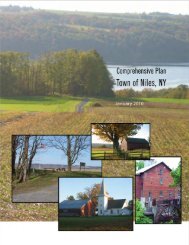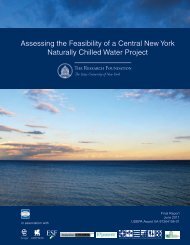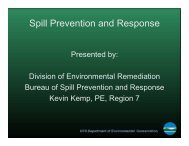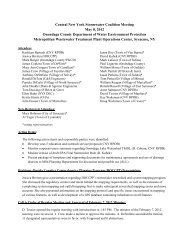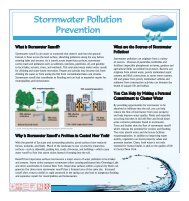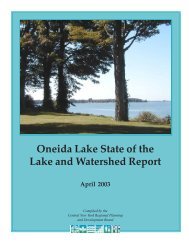A Management Strategy for Oneida Lake and its ... - CNY RPDB Home
A Management Strategy for Oneida Lake and its ... - CNY RPDB Home
A Management Strategy for Oneida Lake and its ... - CNY RPDB Home
Create successful ePaper yourself
Turn your PDF publications into a flip-book with our unique Google optimized e-Paper software.
taking over nest sites or by destroying woody<br />
vegetation that is essential <strong>for</strong> nesting.<br />
Specifically, loss of nesting habitat due to<br />
competition from cormorants on Long,<br />
Wantry, <strong>and</strong> Little Isl<strong>and</strong>s has been detrimental<br />
to the common tern population, a New<br />
York State-listed threatened species.<br />
Since 1998 the NYS DEC has managed the<br />
number of breeding cormorants on <strong>Oneida</strong><br />
<strong>Lake</strong> by limiting reproduction through destruction<br />
of nests <strong>and</strong> treating eggs (with<br />
vegetable oil). The strategy was designed to<br />
reach a population goal of no more than 100<br />
successful breeding pairs each year. This has<br />
been carried out under a permit issued by the<br />
U.S. Fish <strong>and</strong> Wildlife Service to reduce<br />
competition between cormorants <strong>and</strong> nesting<br />
common terns. In 2003 there were approximately<br />
300 nesting pairs of cormorants on<br />
Long Isl<strong>and</strong>. Cormorants were kept off the<br />
other isl<strong>and</strong>s by exclusion devices (e.g.<br />
fencing, mylar tape, pyrotechnics) <strong>and</strong> nest<br />
destruction.<br />
<br />
<br />
<br />
<br />
<br />
<br />
<br />
Participating Organizations<br />
Citizen Task Force on Cormorants<br />
Cornell University<br />
NYS Department of Environmental<br />
Conservation, Division of Fish, Wildlife<br />
<strong>and</strong> Marine Resources<br />
<strong>Oneida</strong> <strong>Lake</strong> Association<br />
U.S. Department of Agriculture, Wildlife<br />
Services / Animal <strong>and</strong> Plant Heath<br />
Inspection Service<br />
United States Fish <strong>and</strong> Wildlife Service<br />
United States Geological Survey<br />
Current Programs, Regulations<br />
<strong>and</strong> Guidelines<br />
Regulations: The Migratory Bird Treaty<br />
Act, originally passed in 1918, provides<br />
protection <strong>for</strong> migratory birds. Under the Act,<br />
it is unlawful to take, import, export, possess,<br />
buy, sell, purchase, or barter any migratory<br />
bird. Feathers or other parts, nests, eggs, <strong>and</strong><br />
products made from migratory birds are also<br />
covered by the Act. “Take” is defined as<br />
pursuing, hunting, shooting, poisoning,<br />
wounding, killing, capturing, trapping, or<br />
collecting. It is legal to hunt under this act<br />
during the designated seasons or with a<br />
permit. Amendments to the Act in 1972<br />
af<strong>for</strong>ded protection to the double-crested<br />
cormorant.<br />
Programs <strong>and</strong> Guidelines: A Citizen<br />
Task Force was convened in 1994 by NYS<br />
DEC to develop management objectives <strong>for</strong><br />
the double-crested cormorant on <strong>Lake</strong> Ontario<br />
<strong>and</strong> <strong>Oneida</strong> <strong>Lake</strong>. The Task Force was made<br />
up of individuals representing sport fishermen,<br />
tourism, environmental interests <strong>and</strong> other<br />
stakeholders.<br />
In 1998, the fall hazing program began under<br />
USDA Wildlife Services <strong>and</strong> NYS DEC<br />
Division of Fish, Wildlife <strong>and</strong> Marine Resources.<br />
The aggressive harassment program<br />
discourages cormorants from stopping over<br />
<strong>and</strong> reduces their time spent on <strong>Oneida</strong> <strong>Lake</strong>.<br />
In addition, nests are destroyed <strong>and</strong> eggs are<br />
treated to limit cormorant reproduction on<br />
<strong>Oneida</strong> <strong>Lake</strong>. It has been effective in moving<br />
birds off <strong>Oneida</strong> <strong>Lake</strong> during the first week of<br />
September (one month earlier than natural<br />
migration occurs). The NYS DEC <strong>and</strong> the<br />
USDA Wildlife Services Unit have also<br />
investigated the use of sound <strong>and</strong> visual<br />
deterrents to alter cormorant migration <strong>and</strong><br />
roosting patterns on <strong>Oneida</strong> <strong>Lake</strong>.<br />
The U.S. Fish <strong>and</strong> Wildlife Service released a<br />
Final Rule <strong>and</strong> Record of Decision in October<br />
2003 that allows more flexibility in the control<br />
of cormorants in areas where they are causing<br />
damage to public resources such as fisheries,<br />
vegetation, <strong>and</strong> other wildlife. The rule allows<br />
state wildlife agencies, Tribal governments,<br />
<strong>and</strong> USDA Wildlife Services to manage<br />
cormorants without having to obtain individual<br />
annual perm<strong>its</strong>; however they must<br />
Chapter 3: Priority Areas page 71



